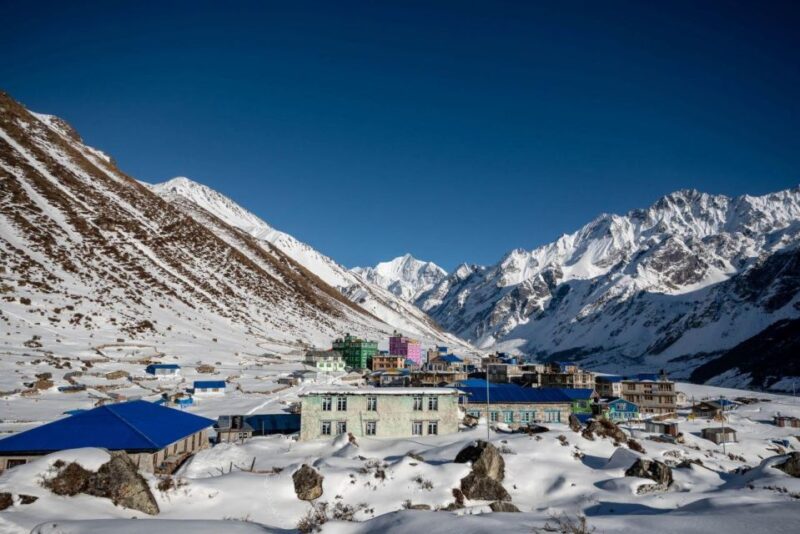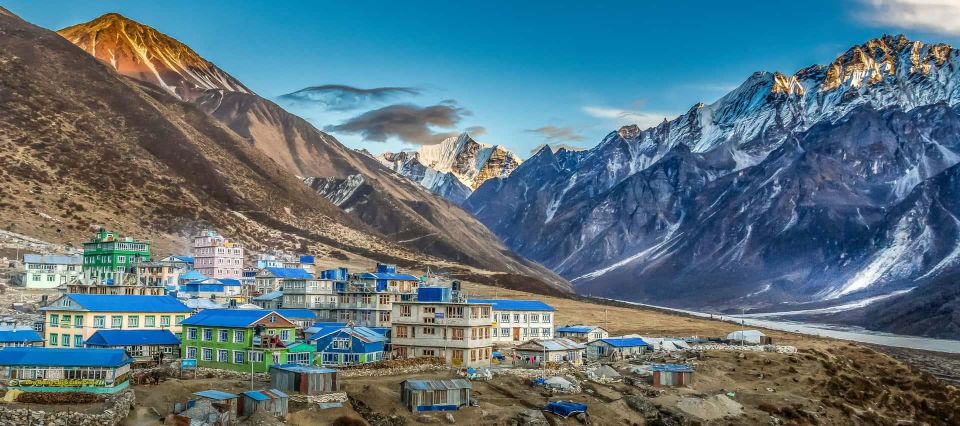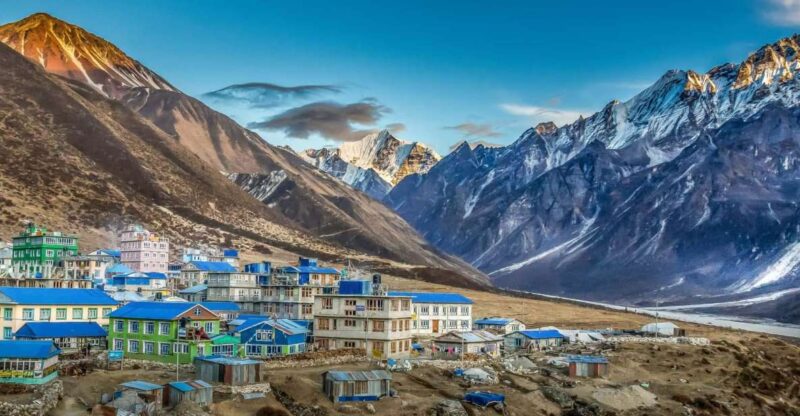The Langtang Trek presents a unique opportunity for those looking to explore the majestic Himalayas of Nepal without breaking the bank. With a seven-day itinerary that highlights stunning landscapes and traditional villages, trekkers can appreciate the region’s rich culture while enjoying the comforts of mountain teahouses. Personalized experiences are ensured with a small group size, making it an ideal choice for adventurers. As trekkers prepare for this unforgettable journey, they might wonder about the best time to embark on such an adventure and what essential packing tips can enhance their experience.
Key Points

- The Langtang Trek is a seven-day adventure through Nepal’s Himalayas, offering stunning views and culture.
- Starting price is €350.81 per person, including accommodation, meals, and permits.
- Ideal trekking seasons are spring (March to May) and autumn (September to November) for favorable weather.
- The trek features local interactions, traditional practices, and breathtaking vistas, particularly from Kyanjin Ri.
- Essential preparations include lightweight clothing, sturdy boots, and proper acclimatization to prevent altitude sickness.
Trek Overview

The Langtang Trek offers an unforgettable adventure through the breathtaking landscapes of Nepal’s Himalayas, perfect for those seeking both natural beauty and culture.
Spanning seven days, this trek takes participants through the stunning Langtang region, where they’ll experience diverse ecosystems and charming villages. With a maximum group size of eight, trekkers enjoy a more intimate and personalized journey.
The trek starts at an accessible price of €350.81 per person, making it a great option for adventurers on a budget. Travelers can communicate in English, Hindi, or Nepali, ensuring a smooth experience.
Plus, the free cancellation policy up to 24 hours in advance allows for peace of mind when planning this incredible journey into the mountains.
You can also read our reviews of more tours and experiences in Langtang Village.
Itinerary Highlights
Kicking off the Langtang Trek, you will drive from Kathmandu to Syabrubesi, taking in the scenic views along the 5 to 6-hour journey.
On Day 2, trekkers will head from Syabrubesi to Lama Hotel, covering about 5 to 6 hours of beautiful trails.
The following day, they’ll trek to Langtang Village, reaching an elevation of 3,430 meters.
Day 4 brings a shorter trek to Kyanjin Gompa, where they can enjoy stunning mountain vistas.
On Day 5, an optional climb to Kyanjin Ri offers breathtaking views before trekking back to Rimche.
The trek concludes with a return journey to Syabrubesi and a drive back to Kathmandu, wrapping up an unforgettable adventure in just seven days.
Included Services

Included in the Langtang Trek package are essential services that ensure a comfortable and memorable experience for all participants. These services cater to various needs, so trekkers can focus on enjoying the stunning landscapes and rich culture of the Langtang region.
| Service | Description |
|---|---|
| Accommodation | 4 nights in mountain teahouses |
| Meals | Three meals daily during the trek |
| Transportation | Bus from Kathmandu to Syabrubesi |
| Guidance | Expert trekking guide |
| Permits | TIMS permit and Langtang valley permit |
Plus, trekkers receive equipment like a trekking map and poles, emergency service arrangements, and a memorable farewell dinner. All these details contribute to an enriching trekking experience.
Exclusions
When planning for the Langtang Trek, trekkers should keep in mind several exclusions that aren’t covered in the package.
First and foremost, there’s the Nepal entry visa fee, which trekkers need to arrange upon arrival.
Travel and rescue insurance is also essential, as it isn’t included in the trek package.
Personal expenses like meals in Kathmandu, bar bills, and tips for guides and porters add up too.
If plans change and trekkers need to return early, they’ll be responsible for those costs.
Lastly, any extra nights needed in Kathmandu for late departures will also be out-of-pocket.
Being aware of these exclusions helps trekkers budget effectively for their adventure.
More Great Tours NearbyExperience and Culture
Trekkers can enjoy the rich culture and traditions of the Langtang region while exploring its stunning landscapes and vibrant local communities.
They’ll encounter welcoming villagers who share their customs, stories, and daily lives. Traditional practices, such as farming and animal husbandry, reflect the deep connection locals have with their environment.
As trekkers move through charming villages, they can experience unique festivals and rituals, often centered around Buddhist and Hindu beliefs.
The breathtaking views from Kyanjin Ri further enhance the trek, offering glimpses of the majestic Langtang mountain range.
This combination of natural beauty and cultural richness makes the Langtang Trek not just a physical journey, but a profound cultural experience that leaves lasting memories.
Best Time to Trek
Choosing the best time to trek in the Langtang region enhances the experience, allowing adventurers to fully appreciate both the stunning landscapes and the vibrant local culture.
Generally, the ideal trekking seasons are spring (March to May) and autumn (September to November). During these months, trekkers can expect clear skies, moderate temperatures, and blooming flora.
Spring offers lush greenery and wildflowers.
Autumn provides breathtaking views of the Himalayan peaks.
The weather’s typically stable, reducing the chances of rain.
These seasons attract fewer crowds than summer and winter.
Cultural festivals often occur, enriching the trekking experience.
Preparation and Packing Tips
Effective preparation and thoughtful packing can greatly enhance the Langtang Trek experience, ensuring trekkers are ready for both the challenges and the breathtaking beauty that awaits.
Trekkers should prioritize lightweight, moisture-wicking clothing suitable for varying temperatures, including a waterproof jacket and warm layers. Sturdy trekking boots are essential for navigating rugged terrain.
Packing a first aid kit, personal medications, and snacks can help tackle any unexpected situations. A quality sleeping bag is also vital for comfortable nights in teahouses.
Don’t forget trekking poles for added stability and a good camera to capture stunning views.
Travel and Safety Tips
Safety during the Langtang Trek hinges on being well-informed and prepared for the unique challenges of the Himalayan environment. Trekkers should prioritize their well-being and adapt to the conditions they’ll encounter.
Here are some essential travel and safety tips to consider:
-
Acclimatize properly to prevent altitude sickness.
-
Stay hydrated and carry water purification tablets.
-
Use trekking poles for stability on uneven terrain.
-
Keep a first aid kit handy for minor injuries.
-
Respect local customs and the natural environment.
Frequently Asked Questions
What Is the Fitness Level Required for the Langtang Trek?
For this trek, a moderate fitness level’s essential. It involves daily hiking for several hours at varying altitudes. Regular walking or hiking practice beforehand will help ensure participants enjoy the experience without undue strain.
Are There Any Age Restrictions for Participants on the Trek?
There aren’t strict age restrictions for participants. However, it’s recommended that younger trekkers have parental consent and older trekkers should ensure they’re physically fit. Everyone’s encouraged to assess their own abilities before joining the trek.
Can I Trek Solo or Only in a Group?
He can’t trek solo; it’s only allowed in groups. The trek’s organized nature ensures safety and camaraderie among participants, making the experience more enjoyable while exploring the breathtaking landscapes and vibrant local culture together.
What Type of Accommodation Is Available During the Trek?
During the trek, participants stay in cozy mountain teahouses, offering basic amenities. Each night, they enjoy shared accommodations, fostering a sense of community while experiencing the unique culture and hospitality of the local environment.
Is There Mobile Network Coverage Along the Trekking Route?
Mobile network coverage varies along the trekking route. While some areas have signal, it’s often limited or non-existent in remote regions. Travelers should prepare for potential disconnection and enjoy the surrounding natural beauty.
Recap
To sum it up, the Langtang Trek offers an unforgettable blend of adventure, culture, and stunning scenery.
With its affordable pricing and small group sizes, trekkers can enjoy the beauty of the Himalayas while enjoying personalized experiences.
Whether it’s the breathtaking landscapes or the rich cultural interactions, this trek is sure to leave lasting memories.
So gear up, embrace the journey, and get ready for an incredible exploration of one of Nepal’s most captivating regions!
You can check availability for your dates here:More Hiking & Trekking Tours in Langtang Village
More Tour Reviews in Langtang Village
Not for you? Here's more nearby things to do in Langtang Village we have reviewed
- Langtang Valley Trek 10 Days
- Guided: Langtang Valley Trek – 8 Days
- Tamang Heritage Trekking 10 Days
- 7 days Shamanism Retreat in Kathmandu
- 2 Best Guided Tours In Langtang Village
- 19 Best Treks And Hiking Tours In Langtang Village
- Best Historical Tours In Langtang Village
- 9 Days Tamang Heritage Trail-Trek to Quaint Tamang Villages
- Nepal: Trekking Guide With 20+ Years of Experience
- Jamacho Nagarjun : Day Hiking Around Kathmandu
- Phulchowki Bird Watching Day Hiking
- Porter for Langtang Trek
